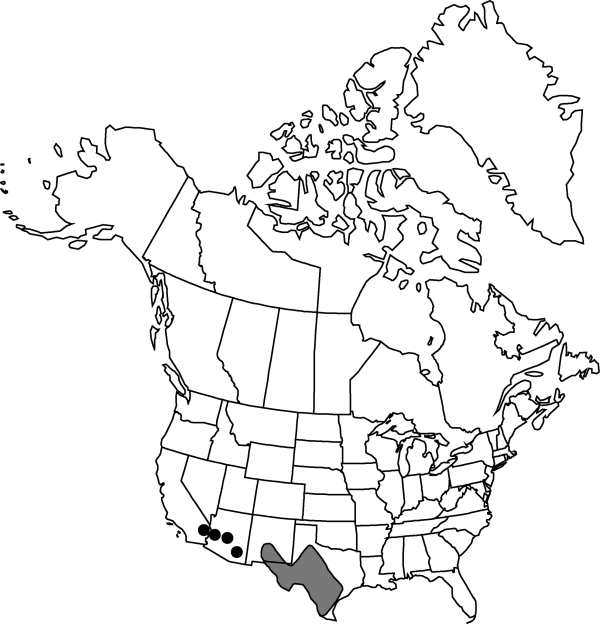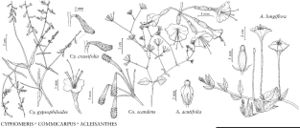Difference between revisions of "Acleisanthes longiflora"
Amer. J. Sci. Arts, ser. 2, 15: 260. 1853.
FNA>Volume Importer |
FNA>Volume Importer |
(No difference)
| |
Revision as of 20:01, 24 September 2019
Plants herbaceous, often slightly woody at base, overall pubescence of white, capitate hairs 0.2–0.4 mm. Stems ascending to prostrate or sprawling, profusely branched, to 100 cm, puberulent to glabrate, occasionally hirtellous. Leaves grayish green, petiolate, those of pair slightly unequal; petiole 1–14 mm, puberulent to glabrate; blade lanceolate to linear-lanceolate or triangular-lanceolate to deltate, 3–40 × 1–30 mm, base cuneate and decurrent, margins undulate or crispate, apex acuminate to acute or long attenuate, glaucous, puberulent to glabrate. Inflorescences solitary flowers, rarely geminate, sessile or with pedicel to 7 mm; bracts linear-subulate, 1–7 mm, puberulent to sparsely so. Flowers: chasmogamous perianth with tubes 7–17 cm × 1–2 mm, puberulent to glabrate, limbs 10–20 mm diam., stamens 5; cleistogamous perianth 5–12 mm, puberulent, stamens 5. Fruits with 5 hyaline ridges and pair of shallow, parallel grooves between ridges, without resinous glands, narrowly oblong, truncated at both ends, constricted 1 mm both below apex and above base, 6–10 mm, hirtellous to puberulent with capitate hairs and many to few, minute, moniliform hairs 0.2–0.4 mm, or glabrate.
Phenology: Flowering Feb–Nov.
Habitat: Rocky, gravelly, loamy, or sandy calcareous, gypseous, or igneous-derived soils in deserts, grasslands, shrublands, or woodlands
Elevation: 0-2500 m
Distribution

Ariz., Calif., N.Mex., Tex., Mexico (Chihuahua, Coahuila, Durango, Nuevo León, Sonora, Tamaulipas).
Discussion
Selected References
None.
